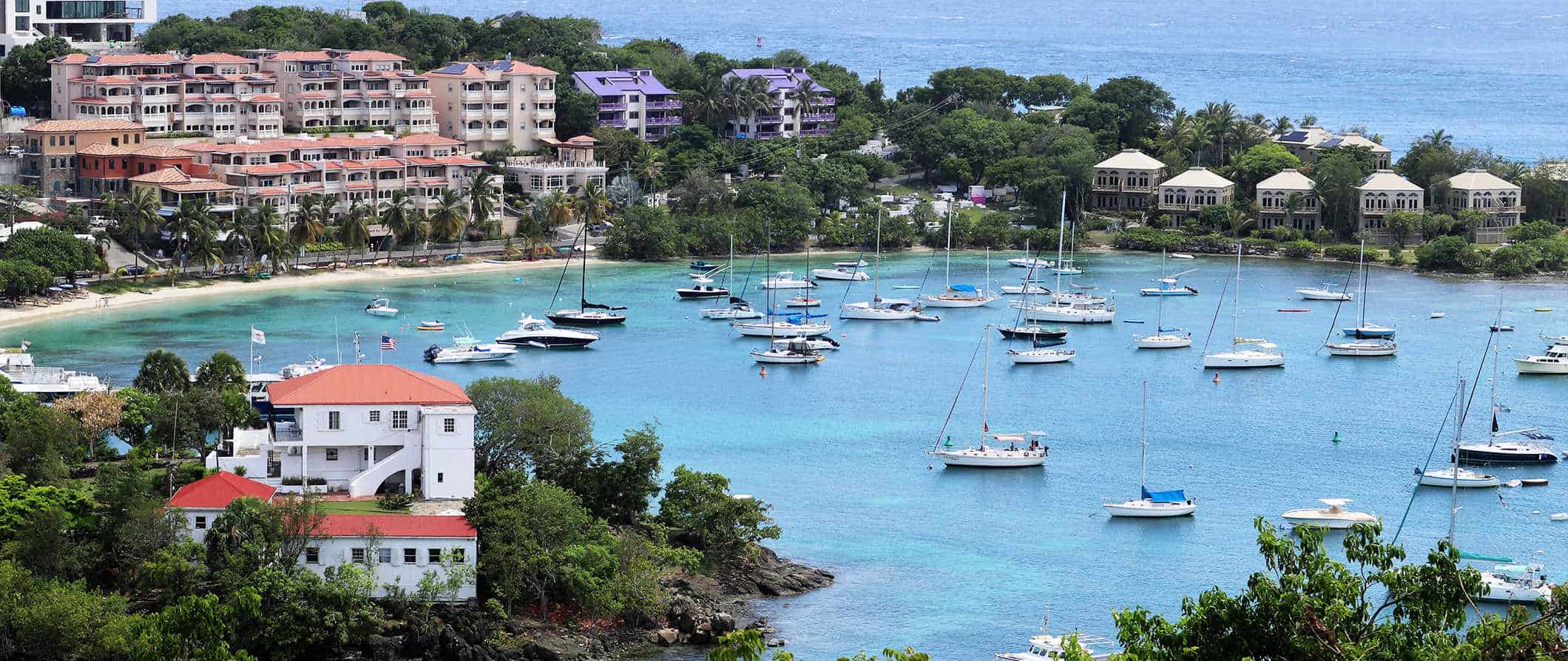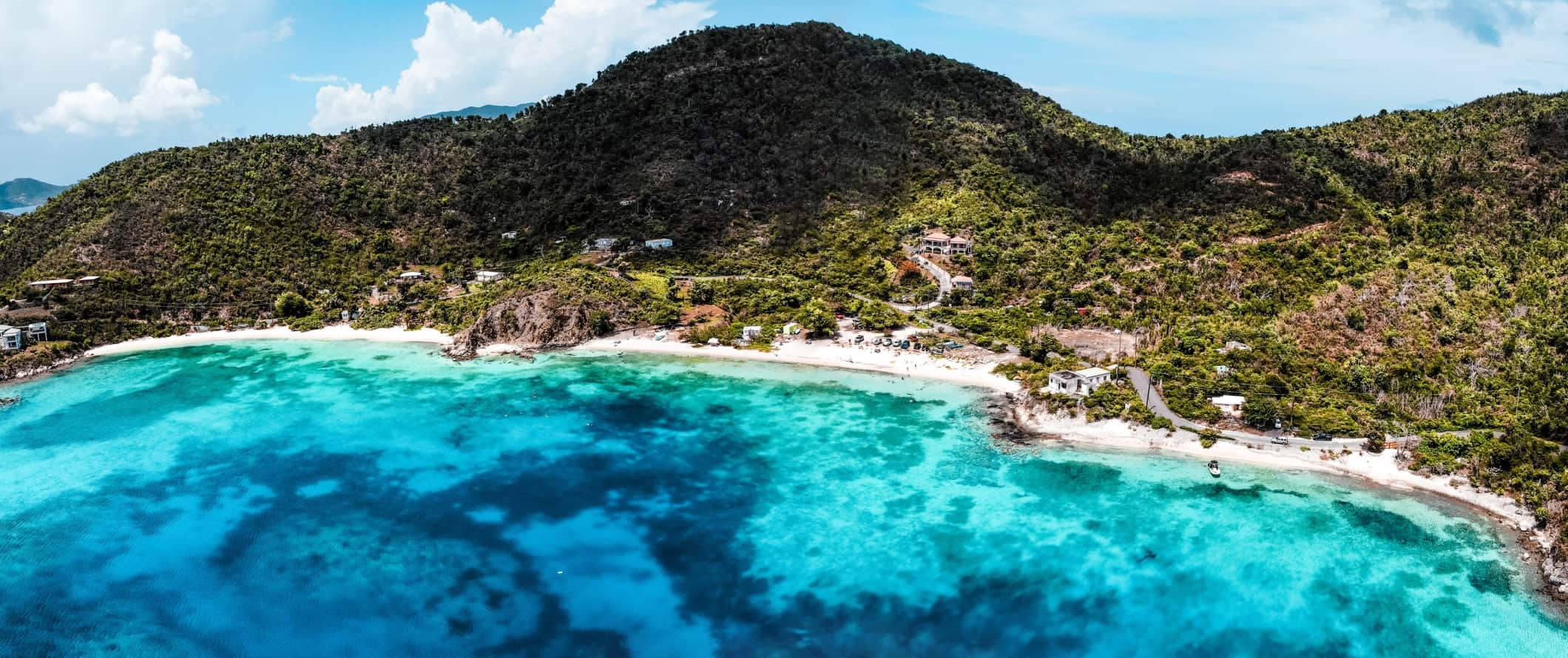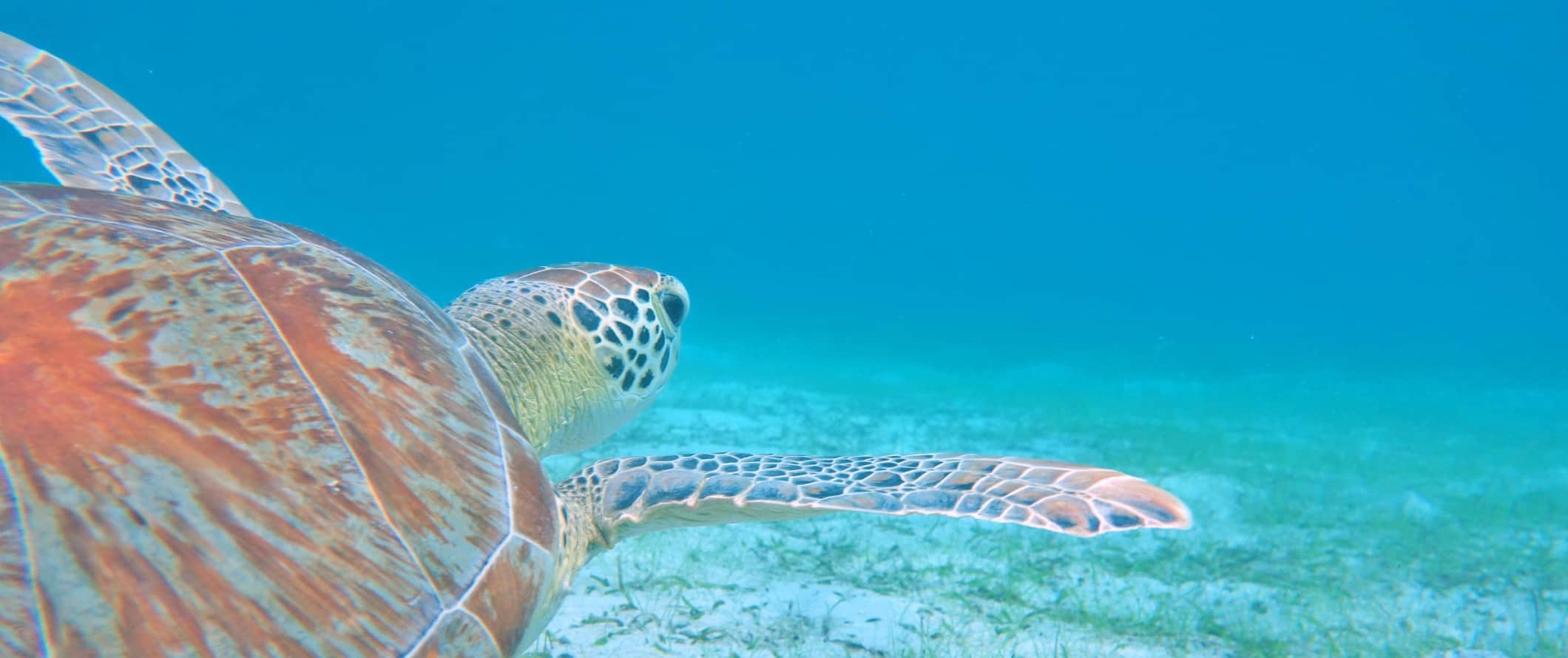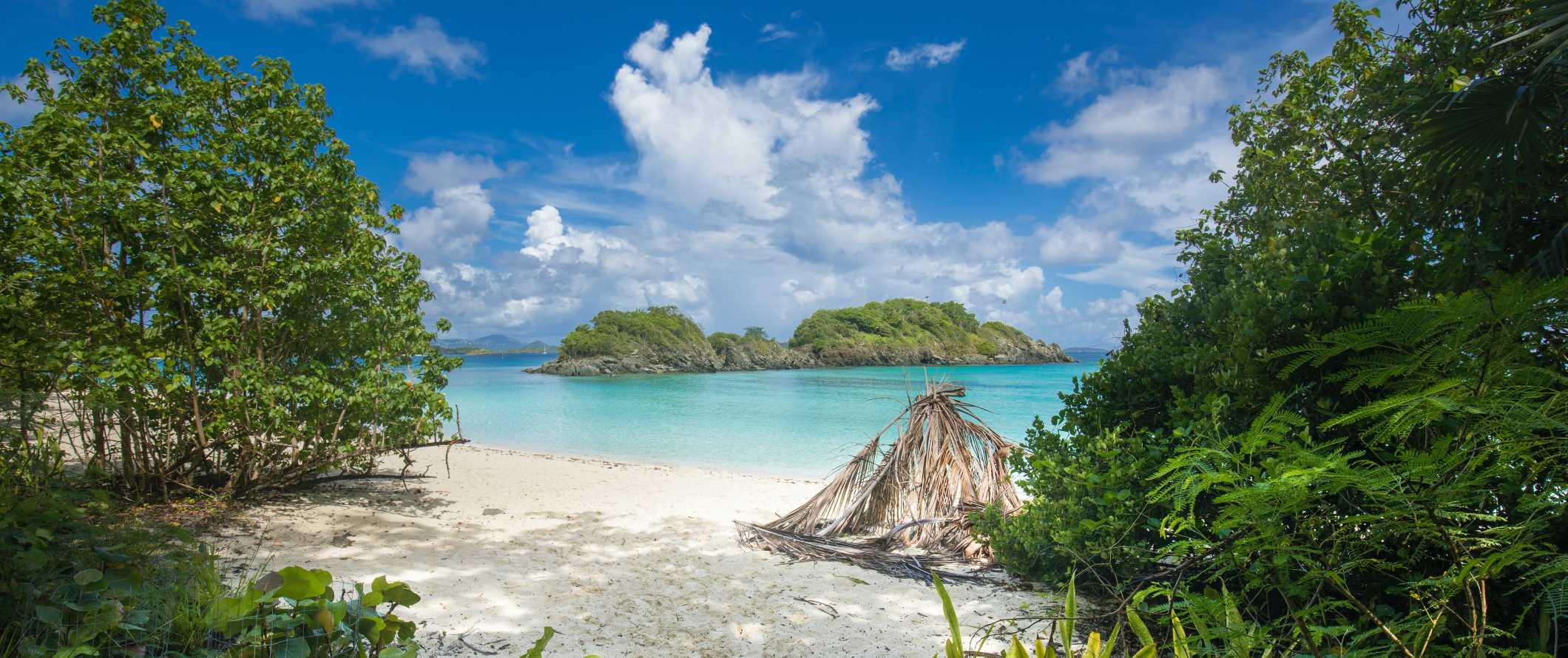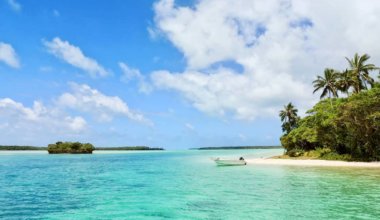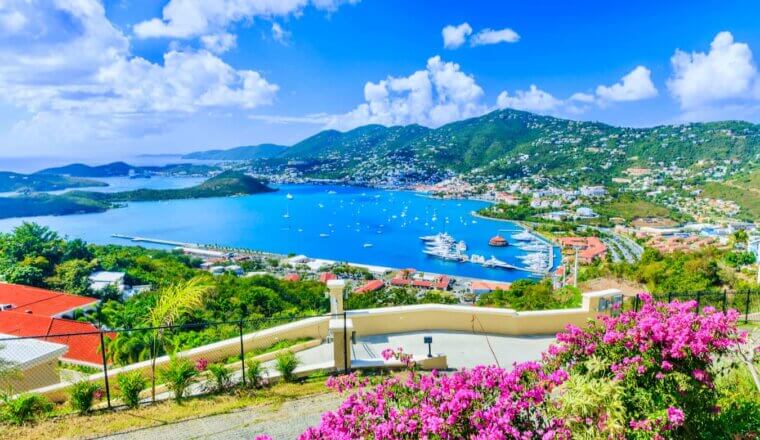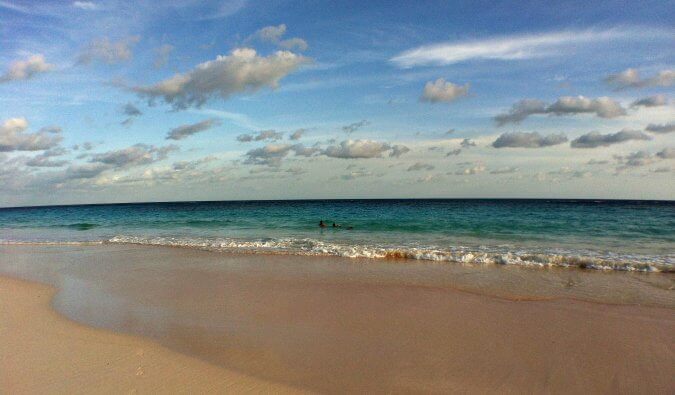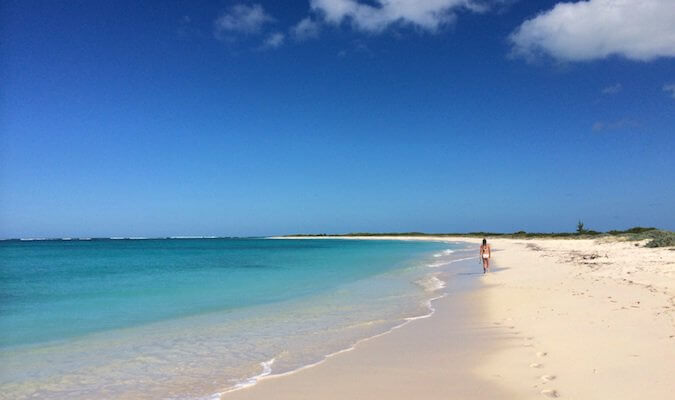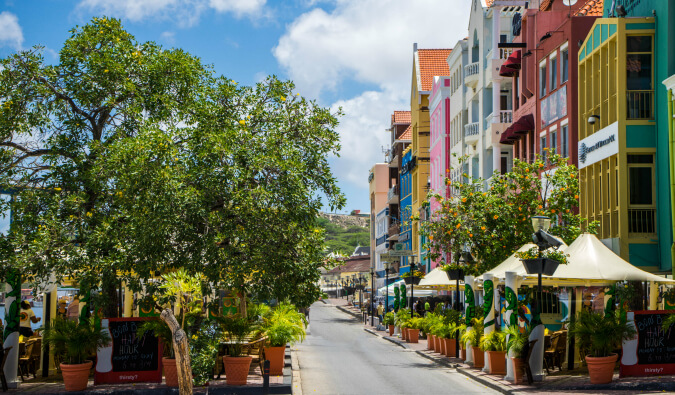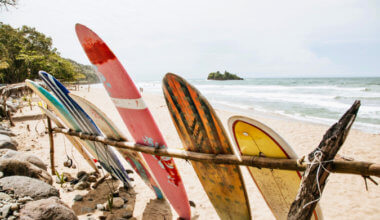Saint John is one of the U.S. Virgin Islands, a U.S. territory located in the Caribbean. Saint John is the smallest of the three main islands, with no airport (though there is a regular ferry service from nearby Saint Thomas).
The U.S. Virgin Islands have been inhabited since at least 1000 CE (you can still view vestiges from that time in the form of petroglyphs). The Netherlands, France, Spain, and Britain each ruled over the island at various points, leaving their mark on the island’s history and culture.
Today, most of Saint John is a national park, which provides opportunities for lots of trekking and wildlife spotting. Out of the three U.S. Virgin Islands, visiting Saint John was the highlight for me: there are lots of trails to hike, tons of beaches to enjoy, plentiful snorkeling opportunities, delicious and affordable food, and a rocking nightlife.
With only about four thousand people living on the island, the small community here really knows each other. You’ll run into people over and over again. It has the most laid-back feel and is the one USVI island you’ll probably want to spend the most time on!
This Saint John travel guide can help you plan your trip, save money, and make the most of your visit.
Table of Contents
Top 5 Things to See and Do on St. John
1. Visit the beaches
Saint John’s beaches are world famous for their perfect, crystal clear waters and powdery white sand, many of which are protected by the National Park Service due to their delicate ecosystems. It’s pretty hard to go wrong here, but there are some top beaches you shouldn’t miss. If you want to hang out with other travelers, head to Trunk Bay ($5 USD) for lush tropical plants and fantastic snorkeling. You can also go snorkeling in the crystal-clear waters around Hawksnest or hike to the best snorkeling spot in St. John (Waterlemon Cay) on the eastern end of Leinster Bay to see starfish, turtles, and incredible corals and tropical fish. Or, soak up the calm, shallow shores of quiet Maho Bay or Oppenheimer Beach, a quiet place to chill under the trees, snorkel, and just enjoy the tire swing away from the crowds.
2. Visit Annaberg Plantation
This historic sugar mill and former slave plantation from 1780 was St. John’s biggest sugar and molasses producer. It’s located on the north side of the island down a great walking trail and past a few sparking bays. The plantation was originally owned by the first Danish merchant and Governor of St. Thomas, Frederik Christian Hals von Moth. The old windmill at Annaberg is the largest on the island and was constructed around 1830. The plantation site is small but gives you a sense of what the sugar mills looked like, highlighting the horrific realities of slavery as well as the history of slave uprisings. You can visit dilapidated ruins on your own and check out the schooner drawings on the dungeon wall that date back more than 100 years.
3. Go hiking in Virgin Islands National Park
St. John is two-thirds national park and there are a ton of trails that criss-cross the entire island meant to preserve the tropical ecosystem and local culture. The main highlights of the park are the stunning beaches of Trunk Bay, Cinnamon Bay, and Mayo Bay as well as the natural scenic landscapes and hiking trails. The most popular trails are the Cinnamon Bay Nature Trail and the challenging (yet totally worth it) Reef Bay Trail. It has a steep ascent up to the peak as well as a three-mile trek through tropical forests and plantation ruins, leading you to a swimming beach at Reef Bay. Bring lots of sunscreen and water!
4. Go sailing
If you want to appreciate the Caribbean beauty around St. John, hop on a sailing tour for a day of snorkeling and soaking up the sun on some of the most beautiful waters in the world. Most full-day tours provide food and unlimited booze (half-day tours usually don’t). Cruz Bay Watersports has day sails starting from $120 USD per person or you can do a three-hour snorkeling tour on a catamaran for around $85 USD. Half-day sail and snorkeling to the National Wildlife Marine Refuge swimming with sea turtles costs around $123 USD.
5. Go diving
The warm, crystal-clear water provides great opportunities to see tropical fish and thriving coral reefs as well as octopuses, moray eels, and sea turtles. The underwater floor has unique geological formations, volcanos, and incredible ledges. Some of the most famous dive sites include the Ledges of Little St. James; Cow & Calf Rocks (with volcanic lava tubes you can swim through if you’re not claustrophobic); and The Cartanza Senora, a fascinating World War II shipwreck. A PADI certification costs around $495 USD while a two-tank dive costs $130-45 USD.
Other Things to See and Do on St. John
1. Enjoy some water sports
There are all kinds of watersports on St. John. You can windsurf, jet-ski, kitesurf, snorkel, sail, kayak, and more. Really, there’s nothing you can’t do. Virgin Islands Ecotours is a good company to go with for some light adventure, like a kayaking trip to Henley Cay ($75 USD for a 3-hour trip or $110 USD for a full-day tour). Or there’s the Honeymoon Beach Day Pass, which includes all kinds of rentals for kayaks, stand-up paddleboards, snorkel gear, lounge chair, lockers, and more, for $49 USD.
2. Visit Catherineberg Ruins
This historic plantation site is a former 18th sugar and rum factory. There is not a huge amount to see, but it’s worth a visit if you’re hiking in the area. The ruins are well preserved, so you get a good sense of how sugar was harvested and refined on the island. Admission is free.
3. Celebrate Carnival
St. John’s Carnival traditionally culminates in a 4th of July parade as islanders celebrate the United States’ Independence Day. Festivities include mocko jumbies (stilt walkers/dancers), calypso music, and the crowning of Ms. St. John and the Carnival King. There is plenty of delicious food, dancing, singing, plenty of drinks, and spectacular fireworks marking the end of the festival. Just book early as accommodation disappears fast!
4. Drink at the Tap Room
St. John’s flagship brewery, The Tap Room, is in Mongoose Junction, a shopping and dining complex located in Cruz Bay. Choose from the likes of Tropical Mango Pale Ale and Sunshine Belgian Wheat Ale (my favorite). This is the best place to get a beer on the island. They have happy hour every day from 4-6pm with $1 off draft beers and $5 off pizzas.
5. Explore Coral Bay
Located on the far end of the island, Coral Bay is a quiet community that was described to me as “St. John before the tourists came to Cruz.” This is a tiny community where most restaurants and bars shut early, usually around 8pm. Be sure to eat at Skinny Legs while you’re over here.
6. Explore Hurricane Hole
This bay on the eastern side of the island is protected by the many mangrove trees growing here. It’s an amazing place to snorkel because there is a diverse and colorful habitat of fish in the water beneath the trees. You’ll likely see snappers, starfish, barracuda, sea anemones, and much more. You can do a full-day kayaking and snorkeling tour for about $120 USD.
7. Party hard with the locals
St. John is the party island of the region. If you are coming to the USVIs and looking for cheap drinks, late nights, and live music then St. John is for you (if you’re not into that, don’t worry. It’s super easy to get away from that and relax). Cruz Bay has the most bars and clubs. Beach Bar and Joe’s Rum Hut always guarantee a good time!
8. Hunt for petroglyphs
Hike the lush Reef Bay Trail to view petroglyphs that date to 900-1400 CE. These rock carvings were created by the Taíno, indigenous people who inhabited the island long before Columbus arrived. There are a variety of carvings, from faces to glyphs that are thought to mean water, as they are located by a deep pool and waterfall. Once you’ve seen the petroglyphs, you can keep hiking to Reef Bay Sugar Mill ruins along the water. To return, hike back along the same trail. The entire hike is about 4.5 miles (7.2 kilometers) roundtrip.
9. Eat tacos on the ocean
Located in Coral Harbor, LimeOut is a floating taco boat that’s only accessible by sea! If you want to eat some tacos and have a beer or craft cocktail while floating in the warm Caribbean water, this is your spot. The boat is eco-friendly too, as it’s run entirely on solar power. There are tons of options, from BBQ to vegan tacos and it’s open from 11am to 5pm every day. Note that you can’t paddle up on a kayak or paddle board; if you want to get served here you have to be on a boat.
For information about other Caribbean destinations, check out these guides:
St. John Travel Costs
Hostel prices – There are no hostels on Saint John, and unfortunately, Hurricane Irma has shut down the only budget-friendly campground on the island. Until Cinnamon Bay reopens, you’ll have to find an affordable hotel or Airbnb property. If you don’t mind being outside the main towns, there are some smaller guesthouses and hotels that range $100-150 USD per night.
Budget hotel prices – The most affordable hotel rooms on St. John start from a pricey $229 USD per night during the low season. Prices shoot up an extra $100 per night in high season. Expect amenities like free Wi-Fi, AC, TV, and often free breakfast.
Airbnb is widely available on St. John, with private rooms costing about $150 USD (though they average triple that price). A full apartment starts at $200 USD per night, though prices average close to $400-500 USD per night.
Food – Traditional cuisine on Saint John relies heavily on seafood, though the island has a unique mix of dishes. Fish and fungi (pronounced foon-ji) is the national dish, which combines cornmeal dumplings with fish fillets (traditionally, it would be salted fish, owing to the island’s Danish heritage). Johnnycakes, conch fritters, roti, cow heel soup (a soup made with cow’s feet), and callaloo (a West African stew) are other popular dishes.
If you’re on a budget, there are a lot of roadside stalls serving fruits, veggies, grilled foods, and other meals for $6-7 USD. In general, $12 USD gets you a fish or chicken plate or a burger. A meal of conch fritters costs $11 USD while rice and beans (a Caribbean staple) or a fast-food meal is at least $9 USD.
For main courses, steak, fish, or seafood, you’re looking at $25 USD or more in a mid-range restaurant. At an upscale restaurant (like at a resort), expect to pay upwards of $50 for a dish like swordfish or lobster, and a glass of wine is another $10 USD.
A cappuccino is generally around $5 USD while beer is $4-6 USD.
My favorite places to eat in St. John are Skinny Legs and Woody’s Seafood Saloon.
Groceries tend to be relatively expensive here because they have to be imported. A week’s worth of groceries, including pasta, meat, and some produce, costs $75-100 USD.
Backpacking St. John Suggested Budgets
If you’re backpacking St. John, my suggested budget is around $210 USD per day. This budget covers a private Airbnb room, taking the bus, cooking your own meals, and taking advantage of free activities like swimming and lounging on the beach. If you plan on drinking, you’ll need to add $5-15 USD to your daily budget.
A mid-range budget of $355 USD covers staying in a private Airbnb apartment, eating out for some of your meals, taking a couple of taxis, enjoying a few drinks, and doing the occasional paid activity like kayaking or diving.
For a “luxury” budget of about $570 USD or more per day, you can stay in a hotel, eat out for all your meals, get a rental car, drink more, and do whatever tours and activities you want. This is just the ground floor for luxury though. The sky is the limit!
St. John Travel Guide: Money-Saving Tips
St. John can really add up if you’re not careful, but it’s not nearly as expensive as other islands in the Caribbean. If you stick to the free hikes, cook your meals, stay in budget-friendly accommodation, and stick to the happy hours, you’ll get by without breaking the bank. It won’t be cheap, but it won’t cost an arm and a leg either. Here are ways to save money on St. John:
- Stay with a local – Use hospitality networks like Couchsurfing to stay with locals for free. There are a handful of hosts on the island and people are very welcoming!
- Drink during happy hour – Happy hour usually runs from 4pm-6pm and have cheap drinks and food. Take advantage of them to save big!
- Hitchhike on boats – Want to go from island to island? Hitchhike on the boats and save thousands of dollars. Here is how to do it.
- Bring your own snorkel gear – At $10 USD per rental, it’s cheaper to buy snorkel gear before you get to the island.
- Book accommodation in advance – Last minute accommodation bookings cost a fortune. Whenever possible, book in advance. Space is limited here!
- Use hotel points – Got hotel points? Use them! Marriott has hotels all over the Virgin Islands that can be booked with points. Free is always better than spending money. Here’s how to start collecting hotel points today.
- Travel with friends – Since accommodation is so expensive, I wouldn’t recommend going to these islands alone. If you do, your expenses are going to skyrocket. It’s much better to go with someone so you can split costs.
- Get dropped off – Taking a day sail but planning on heading to the next island afterward? Most tour companies will drop you off at no extra charge if the island is nearby. It’s a free ferry!
- Bring a water bottle – The tap water here is not safe to drink so bring a reusable water bottle with a filter to save money and reduce your plastic use. LifeStraw is my go-to brand as their bottles have built-in filters to ensure your water is always clean and safe.
Where to Stay on St. John
St. John does not currently have any hostels or campgrounds, so the only way to find affordable accommodations is by booking an Airbnb or finding a Couchsurfing host. If neither of those options interests you, here are some affordable recommendations for places to stay in St. John:
How to Get Around St. John
Bus – Buses on St. John go from one end of the island to the other and cost $1 USD. They run on Centerline Road (from the Cruz Bay ferry dock through Coral Bay and to Salt Pond Bay). Check Vitranvi.com for schedules. just be aware that they don’t really run on time, so be prepared to wait.
Ferry – The ferry from St. John to St. Thomas is just 15 minutes and costs less than $10 USD each way. You can find the ferry schedule here.
Taxi – Taxi prices are standardized by the government, with most rides costing between $5-14 USD. A taxi from Cruz Bay to Trunk Bay costs $5.50 USD, while Cruz Bay to Salt Bay or Hurricane Hole are both $15 USD each. Prices are subject to change, however, so ask your driver about the fare beforehand.
Bicycle and Moped – Many hotels around St. John rent bicycles and mopeds. Keep in mind that St. John is hilly, so cycling can be challenging. Daily costs average about $30 USD per day for bicycles and $45 USD per day for mopeds.
Car rental – A car rental is the most efficient way to get around the island, although it’s not the most economical (unless you’re traveling with friends). Two of the best car rental services include Courtesy Car and Jeep Rental, and St. John Car Rental, Inc. Rentals start at $80-90 USD per day.
For the best car rental prices, use Discover Cars.
Hitchhiking – Hitchhiking is possible if you’re flexible. While most tourists won’t pick you up, it’s possible to score a ride with locals passing by. Just don’t use your thumb but instead point in the direction you’re going.
When to Go to St. John
As the weather here is always hot, the most popular time to visit is during winter (December to March). Temperatures are often 87°F (30°C) or higher each day. It’s the most lively time to visit, though prices are highest too.
Personally, I think November, early December, and April are the best months to go (the shoulder season). Prices and crowds are not bad, and the weather is sunny but not too hot.
Keep in mind that June to November is hurricane season, so keep an eye on the weather if you visit during this time and make sure you have travel insurance.
How to Stay Safe on St. John
St. John is very safe. It’s a small island with little crime. Despite the safe nature of the island, don’t leave your valuables out in the open at the beach to avoid petty theft. Keep your valuables secure and out of sight when on the buses too, just to be safe.
Solo female travelers should generally feel safe here, however, the standard precautions apply (never leave your drink unattended at the bar, never walk home alone intoxicated, etc.).
Avoid walking on back streets and deserted beaches, especially at night, just to be safe.
Scams here are rare but you can read about common travel scams to avoid right here.
Hurricanes and tropical storms do a lot of damage here. If you can, avoid hurricane season (June to November). Otherwise, keep an eye on the weather and always have a backup plan to get off the island (i.e buy travel insurance).
If you experience an emergency, dial 911 for assistance.
The most important piece of advice I can offer is to purchase good travel insurance. Travel insurance will protect you against illness, injury, theft, and cancellations. It’s comprehensive protection in case anything goes wrong. I never go on a trip without it as I’ve had to use it many times in the past.
Saint John Travel Guide: The Best Booking Resources
These are my favorite companies to use when I travel. They consistently have the best deals, offer world-class customer service and great value, and overall, are better than their competitors. They are the companies I use the most and are always the starting point in my search for travel deals.
- Skyscanner – Skyscanner is my favorite flight search engine. They search small websites and budget airlines that larger search sites tend to miss. They are hands down the number one place to start.
- Hostelworld – This is the best hostel accommodation site out there with the largest inventory, best search interface, and widest availability.
- Booking.com – The best all around booking site that constantly provides the cheapest and lowest rates. They have the widest selection of budget accommodation. In all my tests, they’ve always had the cheapest rates out of all the booking websites.
- Get Your Guide – Get Your Guide is a huge online marketplace for tours and excursions. They have tons of tour options available in cities all around the world, including everything from cooking classes, walking tours, street art lessons, and more!
- SafetyWing – Safety Wing offers convenient and affordable plans tailored to digital nomads and long-term travelers. They have cheap monthly plans, great customer service, and an easy-to-use claims process that makes it perfect for those on the road.
- LifeStraw – My go-to company for reusable water bottles with built-in filters so you can ensure your drinking water is always clean and safe.
- Unbound Merino – They make lightweight, durable, easy-to-clean travel clothing.
- Top Travel Credit Cards – Points are the best way to cut down travel expenses. Here’s my favorite point earning credit cards so you can get free travel!
St. John Travel Guide: Related Articles
Want more info? Check out all the articles I’ve written on backpacking/traveling the Caribbean and continue planning your trip:
9 Ways to Explore the Caribbean Sustainably
My 16 Favorite Things to Do in the Virgin Islands
Bermuda: The Impossible Budget Destination? Maybe Not!
How to Save (and Not Save) Money in the Virgin Islands
I Didn’t Like Curaçao (But I Didn’t Hate it Either)
The Best Places on Costa Rica’s Caribbean Coast
